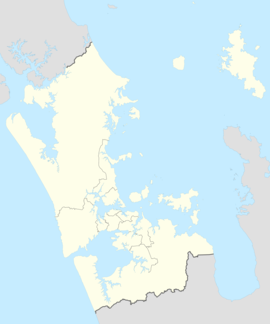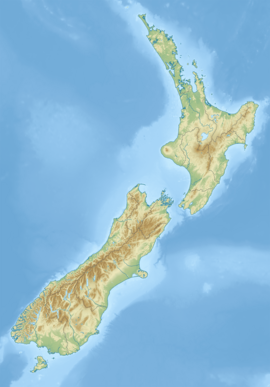Oruamo or Hellyers Creek is a stream and tidal estuary of Upper Waitematā Harbour in the Auckland Region of New Zealand's North Island. It flows through the western North Shore.
| Oruamo or Hellyers Creek | |
|---|---|
 Oruamo or Hellyers Creek in 2003 | |
 Route of Oruamo or Hellyers Creek | |
| Native name | Ōruāmō |
| Location | |
| Country | New Zealand |
| Region | Auckland Region |
| Physical characteristics | |
| Source | Unsworth Heights |
| • coordinates | 36°45′49″S 174°42′51″E / 36.76362°S 174.7142°E |
| Mouth | Upper Waitematā Harbour |
• coordinates | 36°47′17″S 174°40′41″E / 36.78801°S 174.67806°E |
| Basin features | |
| Progression | Oruamo or Hellyers Creek → Upper Waitematā Harbour → Waitematā Harbour → Hauraki Gulf |
| Tributaries | |
| • left | Kaipātiki Creek |
Geography
editOruamo or Hellyers Creek is an arm of the Upper Waitematā Harbour.[1] The creek begins as a freshwater stream, flowing south-west from Albany Highway.[2] The freshwater section is also known as the Waikahikatoa Stream, or the Lignite Stream.[3] A major tributary to the creek is the Kaipātiki Creek, which flows north-west through Birkenhead and Birkdale.[4] Sunset Bay is found on the southern shores of the estuarial mouth of the creek.[5]
History
editThe traditional Tāmaki Māori name for the creek, Ōruāmō is a contraction of Ō-rua-ā-Mōkai-ō-Kahu ("The Lair of Mōkai ō Kahu"), referring to the guardian taniwha associated with Kahumatamomoe of the Arawa migratory canoe. A rock at the mouth of the creek, Te Ure tū ā Hape, recalls the visit of Rakatāura, the tohunga of the Tainui migratory canoe.[6] Archaeological sites show that Oruamo was an important transportation node for the North Shore area.[7] In the first half of the 19th century, the headlands of Oruamo and Lucas Creek to the north were settled by Te Kawerau ā Maki, and were some of the most densely settled areas of the North Shore by Tāmaki Māori.[8][6] The northern headland of the creek in Greenhithe was the site of Tauhinu, a fortified pā.[3] Other traditional names for sites at Oruamo include Ngā Ngutuko ("The Pouted Lips"), referring to the entrance to the creek, Te Wharauakae ("The Shed of Kae"), the bay east of Greenhithe referring to a Te Kawerau ancestor who was killed here, and Te Okoaratanga, the headland to the east of Greenhithe.[9] During the 1820s, most of the Te Kawerau people in the area fled for temporary refuge during the events of the Musket Wars,[10] returning to the Waitākere Ranges and Te Henga / Bethells Beach years later.[11]
The creek is a traditional source of shellfish,[12] and archaeological middens have been found on the shores of the Kaipātiki Creek.[13]
The southern shores of the creek were one of the earliest areas sold to European settlers. William Webster purchased 320 acres of land in 1837 from Ngāti Whātua chiefs Nanihi and Tuire. Webster onsold the land to Thomas Hellyer, who established a kauri mill and brewery on the property, which he renamed The Retreat.[3][7] The Retreat was one of the first permanent wooden houses constructed on the North Shore,[14] and the site was popular with sailors, who would visit for fresh water and beer.[3] After Thomas Hellyer was found dead in 1841, the business folded.[14][7] The land was purchased by William Crush Daldy in 1845,[7] after which the creek was briefly known as Daldy's Creek.[12]
During the early colonial era, wharfs on the creek were the main means of transportation for communities of the western North Shore,[3] such as Greenhithe, Beach Haven and Glenfield (then known as Mayfield).
The eastern shores of the creek rapidly developed into suburban housing in the 1960s, after the completion of the Auckland Harbour Bridge. This population explosion led the Waitemata County Council to announce plans for a landfill in 1969, in reclaimed land of Oruamo or Hellyers Creek. The plans were widely protested by residents, and were scarpered after the New Zealand Airforce, who insisted that no landfills could be located within one nautical mile of the RNZAF Base at Whenuapai or the RNZAF Station Hobsonville.[15]
Oruamo or Hellyers Creek forms the border between the Kaipātiki and Upper Harbour local board areas.
References
edit- ^ "Hellyers Creek". LAWA. Auckland Council. Retrieved 17 July 2023.
- ^ "Oruamo or Hellyers Creek". New Zealand Gazetteer. Land Information New Zealand. Retrieved 17 July 2023.
- ^ a b c d e Lutz, Heike; Chan, Theresa (2011). North Shore heritage – North Shore area studies and scheduled items list: volume 2 parts 6+ (PDF). Heritage Consultancy Services (Report). Auckland Council. Retrieved 7 July 2023.
- ^ "Kaipātiki Creek". New Zealand Gazetteer. Land Information New Zealand. Retrieved 23 November 2023.
- ^ "Sunset Bay". New Zealand Gazetteer. Land Information New Zealand. Retrieved 17 July 2023.
- ^ a b Te Kawerau ā Maki; The Trustees of Te Kawerau Iwi Settlement Trust; The Crown (12 December 2013). "Deed of Settlement Schedule: Documents" (PDF). Archived from the original (PDF) on 9 June 2022. Retrieved 26 April 2022.
- ^ a b c d Heritage Consultancy Services (1 July 2011). North Shore Heritage - Thematic Review Report Volume 1 (PDF) (Report). Auckland Council. ISBN 978-1-927169-21-6. Retrieved 29 June 2023.
- ^ Gaylard, Doug; Clough, Rod (March 2020). 473 Albany Highway, Albany: Archaeological Assessment (PDF). Clough & Associates (Report). Auckland Council. Retrieved 17 July 2023.
- ^ Simmons, D. R. (1979). "George Graham's Maori Place Names of Auckland". Records of the Auckland Institute and Museum. 16: 11–39. ISSN 0067-0464. JSTOR 42906272. Wikidata Q58677091.
- ^ Verran, David 2010, pp. 19, 28.
- ^ Tatton, Kim (June 2019). "The Historic Māori Settlements oF Waiti Village and Parawai Pā, Te Henga: Research Report" (PDF). Clough & Associated Ltd. Auckland Council. ISBN 978-0-908320-17-2. Retrieved 15 May 2022.
- ^ a b McClure, Margaret (1987). The Story of Birkenhead. Birkenhead City Council. pp. 12–19. ISBN 0-908704-04-6. OL 33998949W. Wikidata Q120679112.
- ^ Rounthwaite, Valerie (1989), The Story of Rural Glenfield, Takapuna: Takapuna City Council, p. 5, OCLC 37482407, Wikidata Q123499466
- ^ a b Verran, David 2010, pp. 35.
- ^ Rounthwaite, Valerie 1989, pp. 79–81.
Bibliography
edit- Rounthwaite, Valerie (1989), The Story of Rural Glenfield, Takapuna: Takapuna City Council, OCLC 37482407, Wikidata Q123499466
- Verran, David (2010). The North Shore: An Illustrated History. North Shore: Random House. ISBN 978-1-86979-312-8. OCLC 650320207. Wikidata Q120520385.

